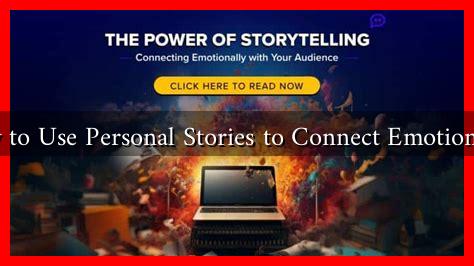-
Table of Contents
- How to Use Personal Stories to Connect Emotionally
- The Power of Personal Stories
- Why Emotional Connection Matters
- Crafting Your Personal Story
- 1. Identify Your Core Message
- 2. Be Authentic
- 3. Use Vivid Details
- 4. Create a Relatable Context
- 5. End with a Strong Conclusion
- Examples of Effective Storytelling
- Statistics on Storytelling Impact
- Conclusion
How to Use Personal Stories to Connect Emotionally
In an increasingly digital world, where communication often feels impersonal, the power of storytelling has emerged as a vital tool for creating emotional connections. Personal stories can bridge gaps, foster understanding, and inspire action. This article explores how to effectively use personal stories to connect emotionally with your audience, whether in writing, speaking, or everyday interactions.
The Power of Personal Stories
Personal stories resonate because they are authentic and relatable. They allow individuals to share their experiences, struggles, and triumphs, creating a sense of empathy and connection. According to a study published in the journal *Psychological Science*, stories activate the brain’s mirror neurons, which help listeners feel what the storyteller feels, enhancing emotional engagement.
Why Emotional Connection Matters
Emotional connections are crucial in various contexts, from marketing to personal relationships. Here are some reasons why they matter:
- Build Trust: Sharing personal stories can establish credibility and trust, making the audience more receptive to your message.
- Enhance Retention: People are more likely to remember information presented in story form than in a list of facts.
- Encourage Action: Emotional stories can motivate people to take action, whether it’s making a purchase, supporting a cause, or changing behavior.
Crafting Your Personal Story
To effectively connect emotionally through personal stories, consider the following steps:
1. Identify Your Core Message
Before sharing your story, clarify what you want to convey. Is it a lesson learned, a challenge overcome, or an experience that shaped your perspective? A clear message will guide your storytelling.
2. Be Authentic
Authenticity is key to emotional connection. Share your true feelings and experiences, even if they are vulnerable. According to Brené Brown, a research professor and author, vulnerability is the birthplace of innovation, creativity, and change.
3. Use Vivid Details
Engage your audience by incorporating sensory details. Describe sights, sounds, and emotions to paint a vivid picture. For example, instead of saying, “I was nervous,” you might say, “My heart raced, and my palms felt clammy as I stepped onto the stage.”
4. Create a Relatable Context
Frame your story in a way that your audience can relate to. Use common experiences or emotions that resonate with them. This relatability fosters a deeper connection.
5. End with a Strong Conclusion
Wrap up your story with a powerful conclusion that reinforces your core message. This could be a call to action, a lesson learned, or an invitation for the audience to reflect on their own experiences.
Examples of Effective Storytelling
Many successful leaders and brands have harnessed the power of personal stories to connect emotionally with their audiences. Here are a few notable examples:
- Oprah Winfrey: Oprah often shares her personal struggles and triumphs, creating a deep emotional bond with her audience. Her story of overcoming adversity resonates with millions, making her a trusted figure.
- Apple: Apple’s marketing campaigns frequently feature personal stories of users who have transformed their lives through technology, making their products relatable and desirable.
- Charity: Water: This nonprofit organization shares compelling stories of individuals whose lives have been changed by access to clean water, effectively motivating donations and support.
Statistics on Storytelling Impact
Research supports the effectiveness of storytelling in creating emotional connections:
- According to a study by the *Hearts & Science* agency, ads that tell a story are 22 times more memorable than those that don’t.
- A survey by *OneSpot* found that 92% of consumers want brands to make ads that feel like a story.
Conclusion
Using personal stories to connect emotionally is a powerful strategy that can enhance communication in various contexts. By identifying your core message, being authentic, using vivid details, creating relatable contexts, and concluding strongly, you can craft compelling narratives that resonate with your audience. As you embrace the art of storytelling, remember that your experiences can inspire, motivate, and connect people in profound ways. For more insights on storytelling, consider exploring resources like TED Talks, where many speakers share their personal stories to inspire change.

